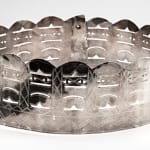-
Artworks
UNIDENTIFIED ARTIST, PROBABLY A COLONIAL SILVERSMITH, POSSIBLY MONTREAL
Eastern Woodlands Trade Silver Crown , c. 1780-1820tooled and pierced trade silver, dimensions variable, 3.25 x 8 x 7 in (8.3 x 20.3 x 17.8 cm)
LOT 142
ESTIMATE: $3,000 — $5,000
PRICE REALIZED: $4,800.00Further images
European, and then colonial, silversmiths produced splendid silver ornaments; these were used first as diplomatic gifts to First Nations chiefs around 1760, then as trade goods in the burgeoning fur...European, and then colonial, silversmiths produced splendid silver ornaments; these were used first as diplomatic gifts to First Nations chiefs around 1760, then as trade goods in the burgeoning fur trade in northeastern North America, via the Hudson’s Bay Company and the North West Company. Brooches, gorgets, armbands, and legbands were some of the works created. The most spectacular objects were headbands in the shape of crowns. Very delicate, they were usually worn on top hats; together, these were treasured as emblems of high rank and prestige. Made exclusively for Indigenous wearers, their cultural significance, too, was purely Indigenous. This crown is a particularly spectacular example (see the references below for several other examples of crowns and headbands.)
One could be forgiven for thinking that it is a simple arrangement of cut-out shapes and stamped designs; when something is made with great skill, it can appear easy. The larger negative spaces in the crown are pierced with a chisel, creating a very fine beveled edge to the silver that pleases both the eye and a wearer’s touch. The delicate line work throughout might be perceived as a hammered stamp to the untrained eye, but is in fact gently pressed by hand, line by line, with a flat graver. This process, pleasingly known as wrigglework, walks a design across the silver. Likely once held together carefully with leather ties that might have sported beads or other adornments, this crown would have been an impressive sight: a shining band of silver against the dark sheen of a beaver pelt top hat.
References: For a fascinating and important discussion of trade silver objects and their functions in various First Nations societies see N. Jaye Fredrickson, The Covenant Chain: Indian Ceremonial and Trade Silver, (Ottawa: National Museum of Canada, 1980). See illustrations of crowns and headbands: fig. 9, p. 30; cats. 26, 29, 61, 64, 166, 174.Provenance
Isaacs Gallery, Toronto;
Private Collection, Toronto;
Estate of the above.
Join our mailing list
* denotes required fields
We will process the personal data you have supplied in accordance with our privacy policy (available on request). You can unsubscribe or change your preferences at any time by clicking the link in our emails.






